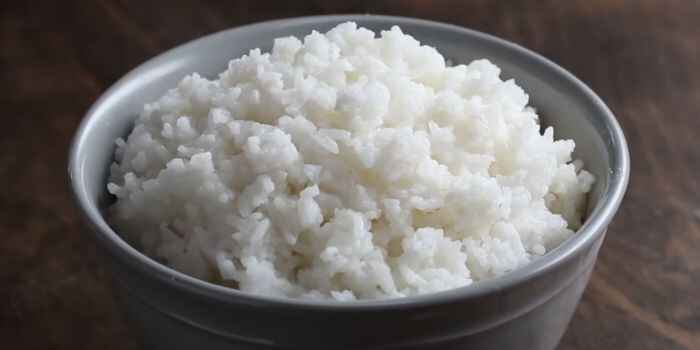Mujorim or Mujolim is a delightful Korean dish made with tender radish that’s slow-cooked in a flavorful, spicy, sweet, and savory sauce. This dish is a perfect match for a warm bowl of rice and is often enjoyed as a side or even as a main dish because it’s incredibly easy to make and wonderfully healthy. The Korean radish or daikon becomes soft and succulent as it absorbs the rich broth flavored with garlic and other aromatic ingredients.
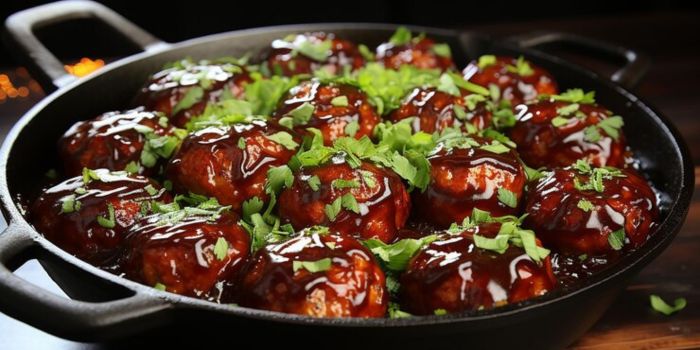
In Korean cuisine, this dish is affectionately called a bap doduk (밥도둑), meaning “rice thief,” because its bold flavors will have you reaching for more rice. Whether you’re enjoying it as a part of a larger meal or on its own, Moojorim (무조림) is sure to satisfy.
What is a Korean radish called?
In Korean cooking, the main type of radish used is called Mu, which belongs to the white radish family. Unlike the long and slender daikon found in other cuisines, Mu is typically shorter and wider, giving it a different texture and appearance. This variety of radish holds a crisp and refreshing taste, perfect for dishes like braised radish.
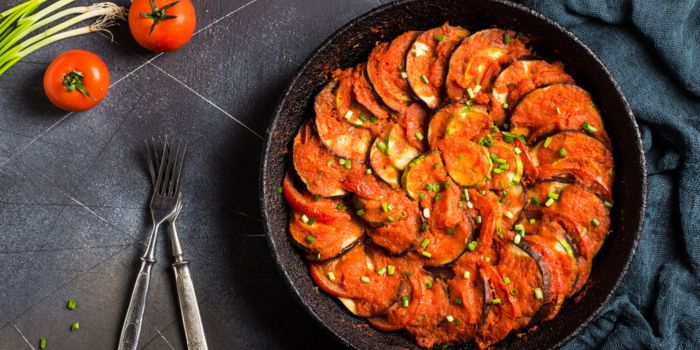
Its slightly spicy flavor is balanced when cooked, making it tender and delicious. Mu radishes are an essential part of many traditional Korean recipes, offering a unique bite that stands out from other radish types, like the thin and long daikon.
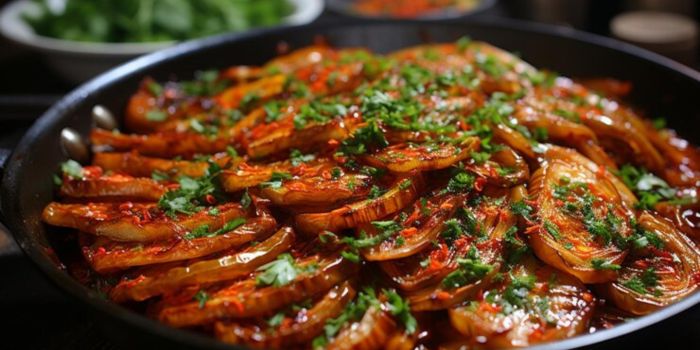
Why I Love This Recipe
This Korean braised radish dish is a perfect introduction to vegetable dishes, especially if you’re looking for something beginner-friendly. It’s incredibly easy to make and uses a slow cooking method called braising, where the radish is gently cooked in a low amount of liquid. This process tenderizes the radish, allowing it to soak up all the delicious flavors from the braising sauce. The result is a dish that’s not only flavorful but also packed with savory umami notes, giving it that rich, comforting taste you’d expect from a fine restaurant.
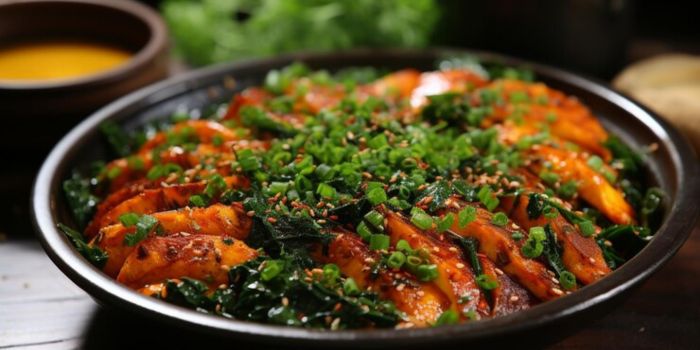
Whether you’re serving it as a side dish or a main, this recipe fits well in any meal. It’s particularly great as banchan, adding variety to your table. Pair it with cold soba noodles for a light, yet hearty meal, making every bite both refreshing and satisfying. Despite its impressive taste, it requires minimal effort to prepare, making it a good choice for any home cook.

Is Korean radish the same as daikon?
When exploring the world of Korean cuisine, you may wonder if Korean mu radish and Daikon are the same. They are indeed similar and often interchangeable in many recipes. However, each type has its own unique flavors. While Daikon radish offers a sweet, mild taste with light, peppery notes, Korean radish tends to be more peppery and less sweet.

This distinct peppery flavor can be beautifully mellowed down through cooking, creating a delightful dish that enhances the taste of any meal. As someone who enjoys experimenting in the kitchen, I can tell you that using these radishes brings out the best in dishes, adding not just taste but also a wonderful texture. It’s always fun to see how these flavors change when prepared in various ways!
Is Korean radish healthy?
Korean radish holds a host of health benefits that everyone should know about! It is low in calories and high in fiber, which makes you feel full after eating. This vegetable is rich in antioxidants and vitamin C, which are great for your overall well-being. Studies have shown that Korean radish can improve digestion, enhance skin health, and boost your immune system.
Overall, it is a great addition to any diet. From my experience, using Korean radish in meals not only makes them tasty but also brings numerous health benefits to the table!

Ingredients:
- 1 lb Korean radish (or substitute with daikon radish), peeled and cut into 1-inch disks
- 2 1/2 cups water
- 1/3 cup chopped scallions (white and green parts separated)
- 1 sliced chili pepper (optional)
- 1 tbsp sesame oil
- 1/2 tsp sesame seeds
Sauce:
- 3 minced garlic cloves (about 1 tbsp)
- 1 tbsp gochugaru (Korean red chili flakes, use coarse gochugaru if needed, adjust to taste)
- 1/2 tbsp sugar
- 1 tsp chicken bouillon (can substitute with dashi powder or mushroom bouillon for vegetarian option)
- 2 tbsp mirin (optional, for sweetness and a slight tang)
- 2 tbsp soy sauce
- 3/4 tsp fish sauce (or soy sauce as a substitute for a vegan/vegetarian version)
- 1/8 tsp minced ginger (optional but recommended for aroma and warmth)
Substitutions:
- If you don’t have fish sauce, use soy sauce as a substitute for a vegetarian option.
- Sugar can replace plum extract.
Instructions:
Prepare the sauce:
- In a bowl, combine minced garlic, gochugaru, sugar, chicken bouillon, mirin, soy sauce, fish sauce, and minced ginger. Mix until fully combined. Set aside.
Prepare the radish:
- Wash and peel the radish, then slice it into 1-inch thick disks. If preferred, you can use cookie cutters to make uniform shapes. Cut the disks in half if needed.
Arrange the radish:
- Place the radish slices into a large pot or pan, arranging them in a single layer. Pour in 2 1/2 cups of water to just about cover the radish slices.
Add the sauce:
- Pour the prepared sauce over the radish. Cover the pot and bring it to a simmer over medium heat.
Simmer:
- Cook covered for about 20 minutes, allowing the radish to soften and absorb the flavors. After 20 minutes, flip the radishes and continue simmering for an additional 15 minutes.
Add scallions and chili:
- Add the white part of the scallions and the sliced chili pepper (if using). Drizzle 1 tbsp of sesame oil into the pot, cover, and continue simmering for 2-3 more minutes or until the braising liquid has reduced and thickened.
Check doneness:
- Test the radish by poking it with a fork or chopstick. It should easily pass through when the radish is tender and fully cooked.
Garnish:
- Turn off the heat and sprinkle the dish with sesame seeds and the green part of the scallions for a fresh finish.
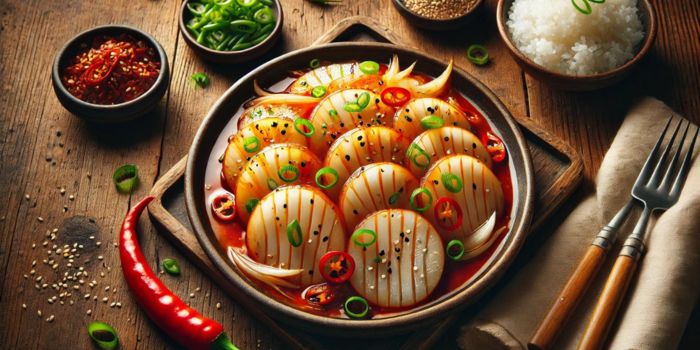
Time Required:
- Prep Time: 15 minutes
- Cooking Time: 35-40 minutes
- Resting Time: None required
Additional Info About Korean Braised Radish Recipe
Here is some additional information that you may have to know about Korean Braised Radish Recipe.
Health Benefits:
- Korean radish (or daikon) is low in calories but high in fiber, aiding in digestion and promoting a healthy gut.
- Garlic and ginger add anti-inflammatory properties and can help boost immunity.
- Gochugaru provides capsaicin, which may support metabolism and weight management.
- Sesame seeds and sesame oil offer healthy fats, supporting heart health and improving skin quality.

Notes:
- This dish pairs well with steamed rice or as part of a larger Korean meal with various side dishes (banchan).
- Adjust the spice level by adding more or less gochugaru or chili pepper.
- You can make this dish ahead of time and refrigerate it for up to 3 days; the flavors will deepen as it rests.
Nutrition (Per Serving):
- Calories: 60-70 kcal
- Protein: 2 g
- Carbohydrates: 8-10 g
- Fat: 3 g
- Fiber: 2 g
- Sodium: 400-500 mg

Equipment:
- Large pot or pan with a lid
- Cutting board and knife
- Measuring spoons and cups
- Mixing bowl
- Fork or chopstick (for testing tenderness)
Serving Suggestions
When I make Korean braised radish, I love to serve it over a big bowl of freshly cooked white rice. This dish is incredibly savory and pairs wonderfully with extra rice. You can enjoy it as a delicious side dish or banchan alongside other main dishes. For a delightful meal, serve it with a spicy beef jerky recipe or even a drizzle of homemade caramel to add a touch of sweetness. Whether you’re sharing it with friends or savoring it alone, this dish will always be a hit at the table!

Storing and Reheating
When it comes to storing and reheating your Korean Braised Radish, it’s so easy! You can make a big batch and store it in the fridge for up to 4 days. This dish is versatile; you can enjoy it cold or hot based on your preference. When you’re ready to eat, just reheat it in the microwave until it’s warm throughout. A great way to enjoy it is to top it on some fluffy rice. It makes for a delicious meal that’s quick and satisfying, perfect for busy days when you want something tasty in no time!

Recipe Tips
When making Korean braised radish, it’s important to cut the radishes into thick, 1-inch disks, half-moons, or wedges to help them retain their shape during cooking. Aim for uniform sizes so they cook evenly. Using a heavy bottom pan or cast iron skillet can be beneficial as it helps distribute the heat well.

Arrange the radishes in a single layer without overlapping to ensure they cook properly. If the braising liquid has evaporated and the radishes are not fully tender, you can add a cup of water gradually until they reach the desired texture. This dish not only looks pretty on a plate, but it also brings a delightful taste that will impress your family and friends.

Do you peel Korean radish?
When making a delicious Korean Braised Radish, it’s important to consider whether to peel the radishes. Personally, I find that peeling them is a great idea because it removes the thick skin and the unwanted fiber. This simple step helps the flavors to soak in better, making the dish taste amazing. When you cook the radishes, the essence of the sauce penetrates deeply, giving you a rich and satisfying flavor in every bite. I always recommend this method to anyone wanting to enjoy the best version of this dish!
What does Korean radish taste like?
Korean radishes have a mild, sweet, and peppery flavor. Eaten raw, they are crisp and succulent. When cooked, the flavor deepens into a smooth and sweet taste that is neutral enough to enhance many dishes. The flesh softens to a velvety texture, adding comfort to your meal. These radishes balance flavors well, making them a great addition to recipes.
How do Koreans eat radish?
In South Korea, radish is a popular cool and crisp side dish, often prepared as vinegar-marinated radish to enjoy with Korean-fried chicken. The cube-shaped radish is diced and soaked in boiling water, vinegar, salt, and a bit of sugar. After marinating for a day, it becomes crunchy and is refrigerated. It’s then served as a substitute for celery sticks, adding a refreshing crunch to meals. This simple dish embodies the essence of Korean cuisine.
Can I eat Korean radish raw?
Yes! You can eat Korean radish raw by making a tasty salad. Just cut the radish into matchsticks for texture. For a simple dressing, combine soy sauce, vinegar, minced garlic, and a bit of sesame oil. This light and refreshing dish is great as a snack or appetizer. Voila! You’ve made something special that’s easy and delicious!
Korean Braised Radish Recipe
Enjoy this easy Korean Braised Radish recipe, made with daikon, garlic, and gochugaru. A healthy, flavorful side dish perfect for any meal!

Ingredients
Method
-
Prepare the sauce
In a bowl, combine minced garlic, gochugaru, sugar, chicken bouillon, mirin, soy sauce, fish sauce, and minced ginger. Mix until fully combined. Set aside. -
Prepare the radish
Wash and peel the radish, then slice it into 1-inch thick disks. If preferred, you can use cookie cutters to make uniform shapes. Cut the disks in half if needed. -
Arrange the radish
Place the radish slices into a large pot or pan, arranging them in a single layer. Pour in 2 1/2 cups of water to just about cover the radish slices. -
Add the sauce
Pour the prepared sauce over the radish. Cover the pot and bring it to a simmer over medium heat. -
Simmer
Cook covered for about 20 minutes, allowing the radish to soften and absorb the flavors. After 20 minutes, flip the radishes and continue simmering for an additional 15 minutes. -
Add scallions and chili
Add the white part of the scallions and the sliced chili pepper (if using). Drizzle 1 tbsp of sesame oil into the pot, cover, and continue simmering for 2-3 more minutes or until the braising liquid has reduced and thickened. -
Check doneness
Test the radish by poking it with a fork or chopstick. It should easily pass through when the radish is tender and fully cooked. -
Garnish
Turn off the heat and sprinkle the dish with sesame seeds and the green part of the scallions for a fresh finish.
Nutrition Facts
Servings 8
- Amount Per Serving
- Calories 70kcal
- % Daily Value *
- Total Fat 3g5%
- Sodium 500mg21%
- Total Carbohydrate 10g4%
- Dietary Fiber 2g8%
- Protein 2g4%
* Percent Daily Values are based on a 2,000 calorie diet. Your daily value may be higher or lower depending on your calorie needs.
Note
- This dish pairs well with steamed rice or as part of a larger Korean meal with various side dishes (banchan).
- Adjust the spice level by adding more or less gochugaru or chili pepper.
- You can make this dish ahead of time and refrigerate it for up to 3 days; the flavors will deepen as it rests.





